


Pop-up notes are active on this page - Click any note number to view
| |

|
Beeston Fire Station -
Like everywhere in the country, fire fighting provision in Beeston evolved from small beginnings, through several stages of more formal stages of development, to become the
highly efficient, well-equipped and professional service we have today. At every stage, dedicated individuals used the resources they had available in the best way they could. This
is the story of this historical development, something about the individuals involved, and the equipment they used.
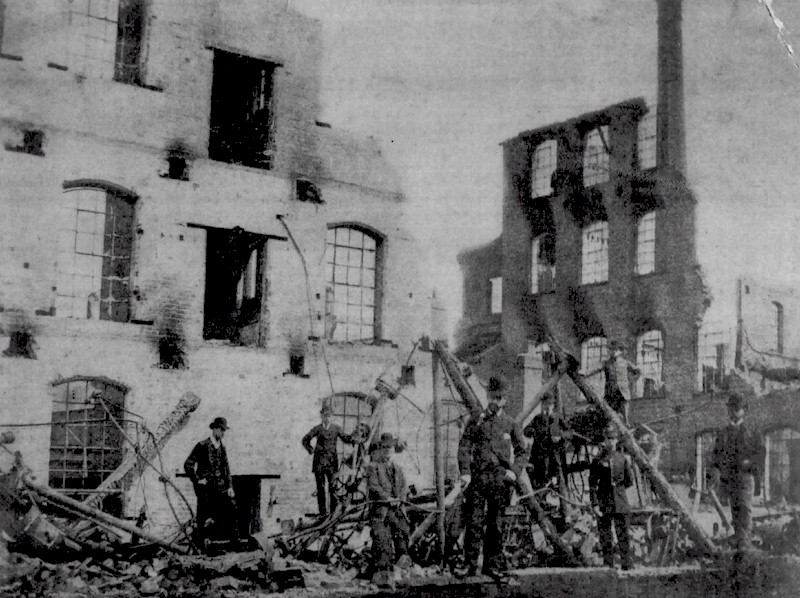 Early Provision : The need for some provision for fighting fires within communities has been seen as a necessity since very early times. Because of the unpredictable way
in which fires occurred - although when they did, often threatening the wider community - solutions tended to focus on volunteers who would respond when fires occurred using what resources
were available - but which gradually evolved as a community-wide resource. Later, there were attempts, particularly in urban areas, to put this on a more formal - and more efficient - basis
by insurance companies, anxious to reduce their fire losses. Later, fire brigades began to be formed in the biggest cities - notably a brigade formed in Edinburgh in 1824 and another formed
in London in 1833 to merge the earlier initiatives by insurance companies 1.
Early Provision : The need for some provision for fighting fires within communities has been seen as a necessity since very early times. Because of the unpredictable way
in which fires occurred - although when they did, often threatening the wider community - solutions tended to focus on volunteers who would respond when fires occurred using what resources
were available - but which gradually evolved as a community-wide resource. Later, there were attempts, particularly in urban areas, to put this on a more formal - and more efficient - basis
by insurance companies, anxious to reduce their fire losses. Later, fire brigades began to be formed in the biggest cities - notably a brigade formed in Edinburgh in 1824 and another formed
in London in 1833 to merge the earlier initiatives by insurance companies 1.
The resources available for fire fighting in Beeston in the 19th century would have been very basic - including
manually operated 'engines' - not coming near the level of equipment and organisation seen in these larger urban areas - and what there was appears to have been managed by the Local Board but
manned largely by volunteers. By the later part of the 19th century, more coverage began to be available as local factories owners sought to establish their own fire fighting provision
to provide some protection to their property in the event of fire - Pollard's nearby Swiss Mills and the Humber Company's works are among those known to have formed their own brigades
2.
This need for improved provision was highlighted particularly by major fires that had destroyed large parts of Wilkinson's Anglo-Scotian Mills on Wollaton Road in 1886 and 1892. Reports of the
1886 fire were particularly telling - despite all efforts and the "Beeston fire brigade under Capt Twigg (being) quickly on scene" what resources there were totally overwhelmed - "Owing to the
inflammable nature of the stores of silk and other laces .. the efforts of the fire brigade (were) useless. The building is now a perfect wreck. The engines are still playing. The disaster is
ruinous to Beeston". (the photograph above right shows what was left of the building. Click the image to see more.) 3.
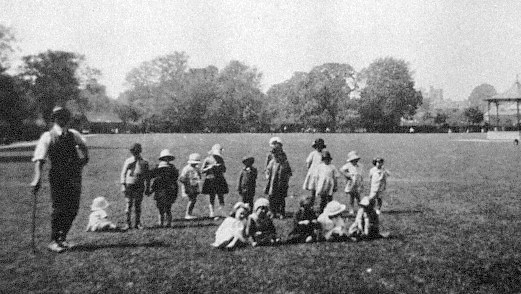 The part-time nature of the brigade at that time is illustrated by the career of the then Captain, William Twiggs (1850-1925). The son of a Leicestershire shepherd, Twiggs came to Beeston in about 1874,
having married Mary Ann Bywater, a local girl, in that year 4. During the course of the rest of his life, he held various posts with the Local Board and
its successor, Beeston Urban District Council. In 1881 he was living with his family on Union Street and was employed as the local lamplighter while, as we have seen in the report of the 1886 fire,
was also the Captain of the fire brigade when it was called out. Twigg's continuing versatility is seen in his later local government roles - by 1891 he was serving as the sexton at Beeston Cemetery
and in 1911 he was a labourer for the Urban District Council 5. It is known that this latter role included service as recreation ground keeper as he is
known to be the figure that appears on a postcard of Dovecote Lane recreation ground from about 1910-1920 (see left).
The part-time nature of the brigade at that time is illustrated by the career of the then Captain, William Twiggs (1850-1925). The son of a Leicestershire shepherd, Twiggs came to Beeston in about 1874,
having married Mary Ann Bywater, a local girl, in that year 4. During the course of the rest of his life, he held various posts with the Local Board and
its successor, Beeston Urban District Council. In 1881 he was living with his family on Union Street and was employed as the local lamplighter while, as we have seen in the report of the 1886 fire,
was also the Captain of the fire brigade when it was called out. Twigg's continuing versatility is seen in his later local government roles - by 1891 he was serving as the sexton at Beeston Cemetery
and in 1911 he was a labourer for the Urban District Council 5. It is known that this latter role included service as recreation ground keeper as he is
known to be the figure that appears on a postcard of Dovecote Lane recreation ground from about 1910-1920 (see left).
Local Council Provision : Beeston Urban District Council was formed in 1894 under the provisions granted in the Local Government Act of that year. Amongst the various responsibilities assigned
to it by that Act, was fire fighting provision and, to that end, it began to pull-together the various, less formal initiatives that had previously served the community. At this stage, it seems,
what did exist was still dominated by enthusiastic volunteers, although a start was soon made to form a more formal brigade with a core of full-time employees with retained staff - that is, men
employed normally elsewhere who report for duty when an emergency arises - which is the model which continues to this day.
In these early days of the Council, it is believed that what equipment the brigade - probably only manually operated appliances - was housed in a building near the top of Brown Lane (now Station
Road) at the side of what was then the Silk Mill. This building was finally demolished as part of the Tesco redevelopment but will be remembered by many in the later part of its life, when it housed
a Pet Shop.
This early building may have been sufficient for a part-time brigade with very basic equipment but the new Council needed something much better to become the Headquarters for the brigade that it envisaged.
Consequently, in February 1907, it resolved to build a purpose-designed fire station at the top end of Stoney Street, a site that was sufficiently central and close to most of the then village. The building was erected
at a cost of some £346, a sum that it borrowed from The Prudential Assurance Company, repayable over 30 years 6. The Brigade now had a new
Headquarters, now it needed new equipment.
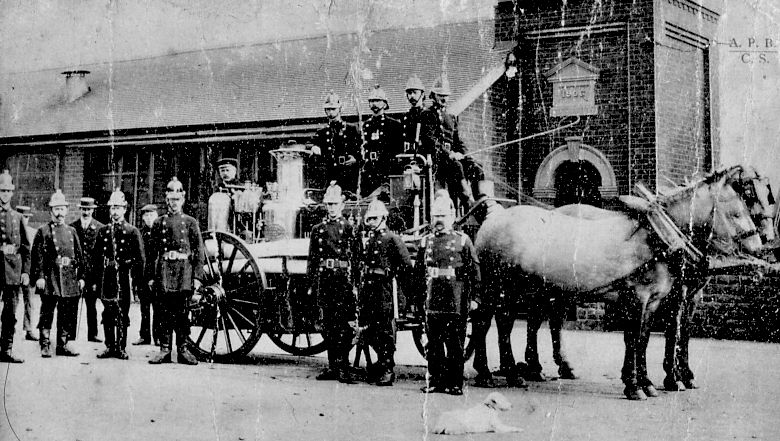
Steam powered fire engines had been used and had greatly improved the efficiency of fire fighting in the large urban centres since the middle of the 19th century and it is therefore not surprising
that in 1892, with the major fire of 1886 still very much in mind, discussion had taken place within the Beeston Board about acquiring a steam powered appliance. Nothing had come of the proposal at the time but
with the reorganisation of the fire brigade being put in place by the new Council, by July 1907, such a purchase was again being actively considered. By January 1908, a tender was accepted from the
Merryweather Company for the supply of its 'Gem' fire engine which, including additional equipment, was purchased for a total of £414 7. This new
engine went into service in Beeston in January 1909; it was capable of pumping 450 gallons per minute with a suction lift of up to 28 feet. The Council - and therefore the community - was now much better served
by a well-manned, well-housed and relatively well-equipped fire brigade - as can be seen from the picture from that era (shown above) which shows a brigade of twelve men - some of whom would be retained
staff - with three others - possibly Council members or official.
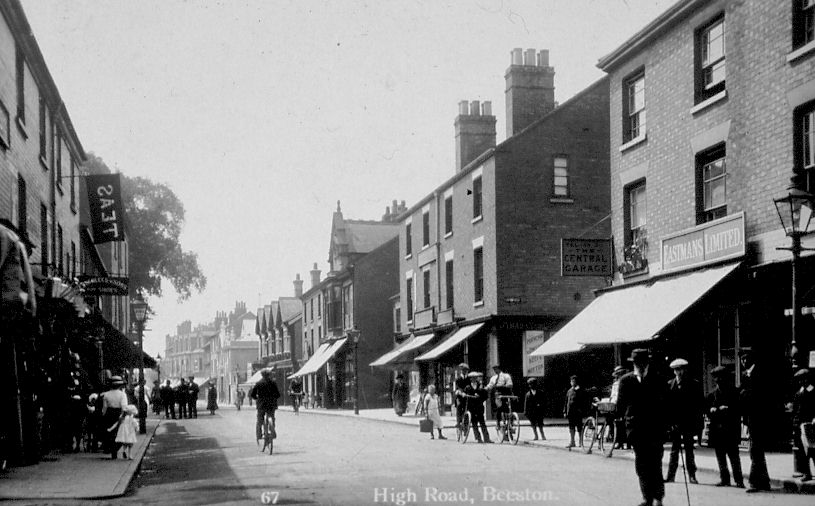 As can be seen in the photograph, the engine was pulled at first by two horses - although sometime later a Council vehicle was used to tow it. With the fire station situated just on Stoney Street, when turning out,
there was a need to make a tight turn with the horse-drawn appliance, either right or left, out of Stoney Street, onto the High Road. To alert the public to this likelihood, a street light on the High Road,
opposite the junction with Stoney Street was adapted to light up with the word "Fire" when the Brigade was about to be dispatched. This can be seen clearly on the left of the photograph
(right), just ahead of the mother walking with her child. The entrance to Stoney Street is on the right, opposite the lamp at the junction. It is an indication of how quiet even the main shopping
street in Beeston was that this simple device was deemed sufficient to alert the public 8.
As can be seen in the photograph, the engine was pulled at first by two horses - although sometime later a Council vehicle was used to tow it. With the fire station situated just on Stoney Street, when turning out,
there was a need to make a tight turn with the horse-drawn appliance, either right or left, out of Stoney Street, onto the High Road. To alert the public to this likelihood, a street light on the High Road,
opposite the junction with Stoney Street was adapted to light up with the word "Fire" when the Brigade was about to be dispatched. This can be seen clearly on the left of the photograph
(right), just ahead of the mother walking with her child. The entrance to Stoney Street is on the right, opposite the lamp at the junction. It is an indication of how quiet even the main shopping
street in Beeston was that this simple device was deemed sufficient to alert the public 8.
The engine was fitted with a quick steaming boiler, which meant that steam could be raised from cold in approximately seven minutes - although by placing a small gas burner over a prepared fire, the boiler could
be kept warm, enabling steam to be raised in under four minutes. Hot coals would be taken from a coal fire in the engine room and placed on the prepared fire. A hand driven induced draft fan could be used if required
to aid firing when on the move to a fire - belying the popular misconception that steam fire engines could not raise steam quickly. With this ability to respond quickly and to perform well when on site, the
engine was a major step forward for fire-fighting Beeston and quickly demonstrated its worth. In May 1917 it attended a major fire at the Humber works in Beeston - then occupied as a lace factory by Sir Arthur
Black - who wrote to the Council to thank the Brigade for its work. Although it had been a difficult task, the fire had been confined to the main wing of the factory withe a major contribution by Beeston's engine
9. In July 1918, when there was a major explosion and fire at the Chilwell shell filling factory, the engine attended and pumped continuously for three days and nights.
A picture of the Beeston fire brigade from this era may be seen here.
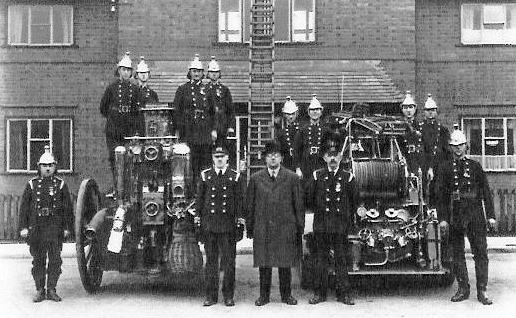
The Merryweather machine provided essentially all fire of Beeston's fire cover for over 20 years until, in April 1929, it was joined by a new Dennis motor appliance 10.
A photograph of both engines together is shown above. This is taken outside a group of buildings on the left at the top of Stoney Street which had been provided for the Brigade as a watch room, on-site accommodation,
offices and training facilities 11. By this time,
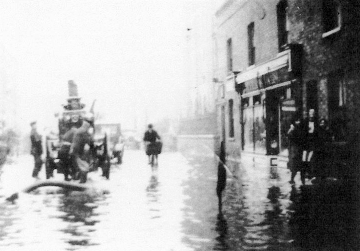 Councilors referred to the old steam appliance as "the coffee pot" and, in the following year it was placed on the reserve list. In 1932 it saw service, helping with flood waters which enveloped the lower
part of Beeston, A photograph showing the engine in action on Queens Road, is shown here.
Councilors referred to the old steam appliance as "the coffee pot" and, in the following year it was placed on the reserve list. In 1932 it saw service, helping with flood waters which enveloped the lower
part of Beeston, A photograph showing the engine in action on Queens Road, is shown here.
Sometime after 1936, the year when Beeston & Stapleford Urban District Council took over all local services, the Merryweather was disposed of - but, that was by no means the end of her. In 1964 it was found to be
owned by a general dealer in Melton Mowbrey who had purchased twelve fire engines from around the Nottingham district - including the Beeston engine. By that date he had cut up eleven of the engines for scrap, leaving
only the Beeston engine, which remained stored behind his house. The survival of this engine came to the attention of the father of Chris Hutchinson, than an Arnold-based garage owner who purchased the engine, towed it
away on its wheels behind his lorry, from Melton to Arnold. The engine was subsequently restored by the Hutchinson family and, following the death of his father in 1987 is now owned by Chris Hutchinson. who is now in the
process of restoring it again. Pictures of the engine in the years following its first restoration, when it appeared at various events, are
shown here.
The Years 1938 to 1948 - in 1938, the Fire Brigade Act made it compulsory for borough and district councils to provide fire fighting services and appropriate equipment in their respective areas. As we have seen,
these requirements had been addressed by the local Council for almost 40 years so it is likely that the response required locally was minimal, probable involving a review of its equipment and organisation against the
requirements laid down by the Act.
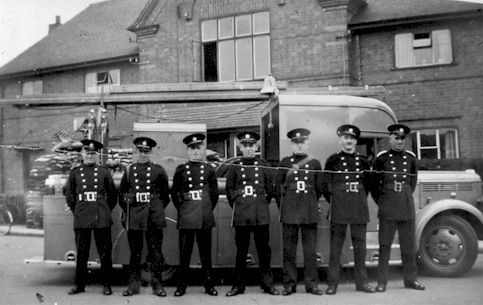 Of course, the Brigade, played a vital role locally during the 2nd World War, when they would have worked alongside their ARP colleagues and the network of fire watchers that was set up. The
photograph (Right) is clearly from that era, as a pile of sandbags, erected for blast protection, can be seen in front of the buildings to the rear. In 1941, the Beeston brigade,
along with all other fire brigades in the country were nationalised under wartime Emergency Provisions to form the National Fire Service. In 1948, under the terms of the Fire Services Act 1947, fire services were
returned to local authority control - but now under the control of the County Councils and County Borough Councils - consequently, Beeston's fire brigade was now operated by Nottinghamshire County Council.
Of course, the Brigade, played a vital role locally during the 2nd World War, when they would have worked alongside their ARP colleagues and the network of fire watchers that was set up. The
photograph (Right) is clearly from that era, as a pile of sandbags, erected for blast protection, can be seen in front of the buildings to the rear. In 1941, the Beeston brigade,
along with all other fire brigades in the country were nationalised under wartime Emergency Provisions to form the National Fire Service. In 1948, under the terms of the Fire Services Act 1947, fire services were
returned to local authority control - but now under the control of the County Councils and County Borough Councils - consequently, Beeston's fire brigade was now operated by Nottinghamshire County Council.
1948 to the Present Day - as we have seen, all fire brigades in Nottinghamshire were now controlled and operated by Nottinghamshire County Council - except the City of Nottingham Brigade, which was not amalgamated
into the County Fire Service until 1974. Although change and improvement in the service would have progressed during the years that followed, local people would have noticed little change in the way it operated as it continued,
for the time being, to be based at the top of Stoney Street.
A series of photographs, with the associated memories of a Beeston fireman's son, who lived at the Stoney Street site in the early 1950s, may be seen here.
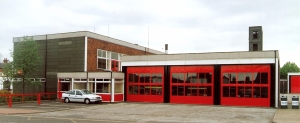 In March 1965, however, a new Fire Station (Shown left) was opened in Beeston, on Station Road at the corner of Middle Street, partly on the site of the old National School. The old site at the top of Stoney Street was
abandoned at that time and subsequently became part of the larger site developed by Sainsburys. The new station served the Beeston area for nearly 45 years but, after coming under the control of the Nottinghamshire Fire & Rescue Service in 1998, it was closed in February 2009. Beeston is now served from the Highfields Fire Station on Hassocks Lane which combines the service previously
provided at the stations in Beeston and in Dunkirk. At the moment (September 2012) the Beeston building stands empty and is expected to be demolished as part of the redevelopment associated with the tram.
In March 1965, however, a new Fire Station (Shown left) was opened in Beeston, on Station Road at the corner of Middle Street, partly on the site of the old National School. The old site at the top of Stoney Street was
abandoned at that time and subsequently became part of the larger site developed by Sainsburys. The new station served the Beeston area for nearly 45 years but, after coming under the control of the Nottinghamshire Fire & Rescue Service in 1998, it was closed in February 2009. Beeston is now served from the Highfields Fire Station on Hassocks Lane which combines the service previously
provided at the stations in Beeston and in Dunkirk. At the moment (September 2012) the Beeston building stands empty and is expected to be demolished as part of the redevelopment associated with the tram.
The author does not claim any specialist knowledge of the history of the Fire Brigade in Beeston - or, indeed, of the Fire Service in general - but has put together this page from the information and images he has available. In
particular, he acknowledges the help received from Chris Hutchinson who provided images and research relating to the Merryweather engine he now owns. He fully expects that there are people who could add much more and invites
them to contact him to pass on any additional information and/or photographs. All contributions which are used will be acknowledged. Contact him at
david@beeston-notts.co.uk
Notes
Return to Top of This Page
© David Hallam - 2012
|
 |


 Councilors referred to the old steam appliance as "the coffee pot" and, in the following year it was placed on the reserve list. In 1932 it saw service, helping with flood waters which enveloped the lower
part of Beeston, A photograph showing the engine in action on Queens Road, is shown here.
Councilors referred to the old steam appliance as "the coffee pot" and, in the following year it was placed on the reserve list. In 1932 it saw service, helping with flood waters which enveloped the lower
part of Beeston, A photograph showing the engine in action on Queens Road, is shown here. Of course, the Brigade, played a vital role locally during the 2nd World War, when they would have worked alongside their ARP colleagues and the network of fire watchers that was set up. The
photograph (Right) is clearly from that era, as a pile of sandbags, erected for blast protection, can be seen in front of the buildings to the rear. In 1941, the Beeston brigade,
along with all other fire brigades in the country were nationalised under wartime Emergency Provisions to form the National Fire Service. In 1948, under the terms of the Fire Services Act 1947, fire services were
returned to local authority control - but now under the control of the County Councils and County Borough Councils - consequently, Beeston's fire brigade was now operated by Nottinghamshire County Council.
Of course, the Brigade, played a vital role locally during the 2nd World War, when they would have worked alongside their ARP colleagues and the network of fire watchers that was set up. The
photograph (Right) is clearly from that era, as a pile of sandbags, erected for blast protection, can be seen in front of the buildings to the rear. In 1941, the Beeston brigade,
along with all other fire brigades in the country were nationalised under wartime Emergency Provisions to form the National Fire Service. In 1948, under the terms of the Fire Services Act 1947, fire services were
returned to local authority control - but now under the control of the County Councils and County Borough Councils - consequently, Beeston's fire brigade was now operated by Nottinghamshire County Council. In March 1965, however, a new Fire Station (Shown left) was opened in Beeston, on Station Road at the corner of Middle Street, partly on the site of the old National School. The old site at the top of Stoney Street was
abandoned at that time and subsequently became part of the larger site developed by Sainsburys. The new station served the Beeston area for nearly 45 years but, after coming under the control of the Nottinghamshire Fire & Rescue Service in 1998, it was closed in February 2009. Beeston is now served from the Highfields Fire Station on Hassocks Lane which combines the service previously
provided at the stations in Beeston and in Dunkirk. At the moment (September 2012) the Beeston building stands empty and is expected to be demolished as part of the redevelopment associated with the tram.
In March 1965, however, a new Fire Station (Shown left) was opened in Beeston, on Station Road at the corner of Middle Street, partly on the site of the old National School. The old site at the top of Stoney Street was
abandoned at that time and subsequently became part of the larger site developed by Sainsburys. The new station served the Beeston area for nearly 45 years but, after coming under the control of the Nottinghamshire Fire & Rescue Service in 1998, it was closed in February 2009. Beeston is now served from the Highfields Fire Station on Hassocks Lane which combines the service previously
provided at the stations in Beeston and in Dunkirk. At the moment (September 2012) the Beeston building stands empty and is expected to be demolished as part of the redevelopment associated with the tram.
 The part-time nature of the brigade at that time is illustrated by the career of the then Captain, William Twiggs (1850-1925). The son of a Leicestershire shepherd, Twiggs came to Beeston in about 1874,
having married Mary Ann Bywater, a local girl, in that year
The part-time nature of the brigade at that time is illustrated by the career of the then Captain, William Twiggs (1850-1925). The son of a Leicestershire shepherd, Twiggs came to Beeston in about 1874,
having married Mary Ann Bywater, a local girl, in that year  As can be seen in the photograph, the engine was pulled at first by two horses - although sometime later a Council vehicle was used to tow it. With the fire station situated just on Stoney Street, when turning out,
there was a need to make a tight turn with the horse-drawn appliance, either right or left, out of Stoney Street, onto the High Road. To alert the public to this likelihood, a street light on the High Road,
opposite the junction with Stoney Street was adapted to light up with the word "Fire" when the Brigade was about to be dispatched. This can be seen clearly on the left of the photograph
(right), just ahead of the mother walking with her child. The entrance to Stoney Street is on the right, opposite the lamp at the junction. It is an indication of how quiet even the main shopping
street in Beeston was that this simple device was deemed sufficient to alert the public
As can be seen in the photograph, the engine was pulled at first by two horses - although sometime later a Council vehicle was used to tow it. With the fire station situated just on Stoney Street, when turning out,
there was a need to make a tight turn with the horse-drawn appliance, either right or left, out of Stoney Street, onto the High Road. To alert the public to this likelihood, a street light on the High Road,
opposite the junction with Stoney Street was adapted to light up with the word "Fire" when the Brigade was about to be dispatched. This can be seen clearly on the left of the photograph
(right), just ahead of the mother walking with her child. The entrance to Stoney Street is on the right, opposite the lamp at the junction. It is an indication of how quiet even the main shopping
street in Beeston was that this simple device was deemed sufficient to alert the public